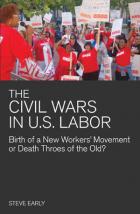Posted June 8, 2011
 The Civil Wars in U.S. Labor:
The Civil Wars in U.S. Labor:
Birth of a New Workers’ Movement or Death Throes of the Old?
By Steve Early
Publisher: Haymarket Books
Steve Early is the Greg Palast of the labor movement! Often authors make labor history extremely bureaucratic and boring, as in a lecture by a college professor who has never been on a picket line. But Steve has been there, and writes with the passion of a dedicated activist who can inform and inspire us.
His new book The Civil Wars in U.S. Labor covers labor history from the sixties to the present, presenting the facts and experiences of those who participated. It contains the struggles, wins, failures, and mistakes. Often folks like Obama want us to “look forward, not backward.” Some people do get trapped in the mire or in the fantasies of the past. But to avoid repeating mistakes and plunging into the “death throes,” it’s necessary to evaluate the past while being part of the struggle to deal with the present overwhelming gap between the rich and poor around the globe.
For four decades I’ve experienced strikes, sell-outs, splits, top- down and bottoms-up locals covering social work, transportation, office work, machine shops, and for the recent decade — homecare in three counties in California. I was there for many of the situations Early describes, and absent from many, as most of us were.
I think he has a unique ability to set up the framework for events, like the trusteeship of the SEIU-UHW-W, and to see it from the inside — from the bureaucrats to the various levels of rank-and-file. Very few of us are able to get that kind of overview, with so many details. Fewer workers these days are able to have decades of experience in one work place.
I’m currently in SEIU 6434 which covers 180,000 Homecare and Nursing Home Workers in California. Most of us, like other home-based workers, are women and minorities, many born in other countries and not all speaking the same language, or having access to the internet. Since we don’t have a common work place, it’s very difficult to keep up with who is involved in the decision-making and what the problems are on various levels. Or to know the history including contracts, trusteeships, mergers, secret template agreements, etc.
We all need to understand the larger labor picture — eg. other union struggles, and national mergers such as with the AFL-CIO and national splits such as the CTW leaving the AFL. We need to know what worked, why, and what doesn’t work anymore and what we need to strategize differently under current changing conditions.
In addition, it helps to know how the politicians have interacted with labor, from the FDRs and Reagans to “Democrats” like Clinton and Obama. In Homecare, we have to negotiate with the Feds, the State, and the County politicians, while trying to catch up with the rights and benefits of the rest of labor, AND — protect the rights of those we care for.
It ain’t easy in this period of massive take-aways! And in a local that recently had a “leader” that stole over a million dollars in our dues, leaving us without normal union resources, something the new Call Centers just can’t replace! We are in the process of reconstructing our local, as are other unions like UNITE, Teamsters and the UAW.
The point is: the more we can know and evaluate past history, the better we can make the tough decisions together as to which strategies will best work for keeping and extending our rights; and for service workers and teachers — will best serve students, the disabled, elderly and poor. Early’s book provides a remarkable resource to aid us in doing just that!
